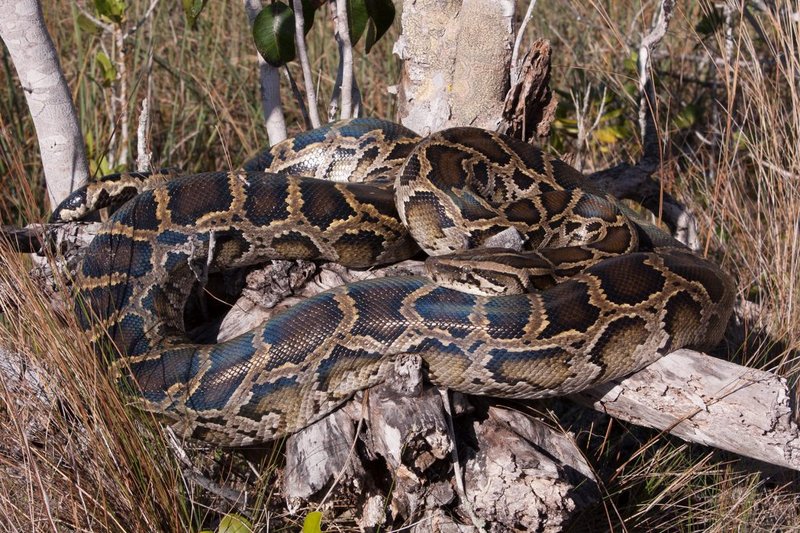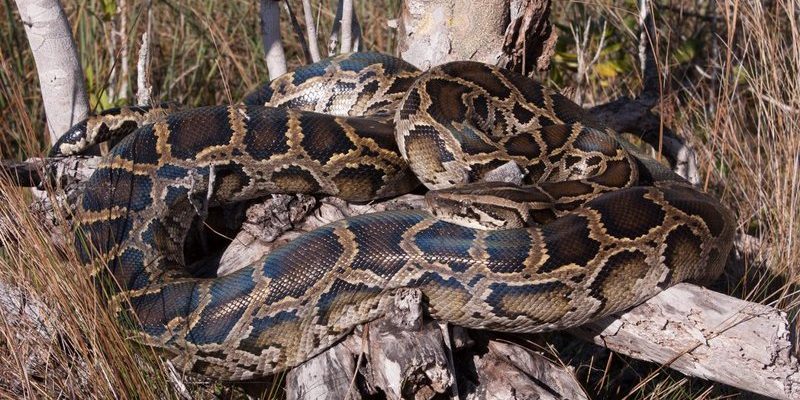
The Burmese Python is a fascinating creature that captures the imagination of many wildlife enthusiasts and curious onlookers alike. Imagine a snake so magnificent that its large, muscular body can grow up to 23 feet long! This snake is not just about size; it’s also about its beautiful patterns and the unique behaviors that set it apart from other snakes. Found primarily in Southeast Asia, the Burmese Python is one of the largest snake species in the world, easily recognizable by its striking yellow and brown coloring, which helps it blend into its natural habitat.
You might be wondering what makes the Burmese Python so interesting. For starters, they are non-venomous constrictors, which means they kill their prey by wrapping around it and squeezing tightly. Unlike other snakes that may strike with fangs, these giants use their incredible strength to subdue animals, from small mammals to larger prey like deer. Their impressive hunting technique is just one part of what makes them such remarkable snakes.
Physical Characteristics
When you think of a snake, you might picture a slender creature slithering through the grass. But the Burmese Python breaks that mold! These snakes boast a stout, muscular body that can weigh anywhere from 50 to 200 pounds, depending on their age and health. Their skin is adorned with a beautiful pattern that typically includes dark brown and yellow splotches, perfect for camouflage in the dense jungles or wetlands they inhabit.
But there’s more to their appearance than just looks. Burmese Pythons have a unique way of moving. Their bodies are incredibly flexible, allowing them to navigate through thick foliage and water with ease. This flexibility, combined with their size, helps them to be effective ambush predators. When they’re lying in wait for their prey, they can be almost indistinguishable from their surroundings, showcasing nature’s brilliant design in evolution.
Habitat and Distribution
The Burmese Python primarily resides in the tropical and subtropical environments of Southeast Asia, which includes countries like Myanmar, Thailand, and Indonesia. These beautiful snakes are often found in a variety of habitats, such as wetlands, marshes, grasslands, and rainforests. They thrive in warm climates, as their cold-blooded nature means they rely on external heat sources to regulate their body temperature.
Interestingly, Burmese Pythons are also known to enjoy life near water. They are excellent swimmers and often hunt for prey in rivers and swamps. Their affinity for both land and water makes them a unique species in the snake family. However, as human activities continue to encroach upon their natural habitats, their populations are becoming increasingly threatened.
Diet and Feeding Habits
As carnivores, Burmese Pythons have a diverse diet that can include a wide range of animals. They primarily hunt small to medium-sized mammals, birds, and even reptiles. This includes animals like rats, rabbits, and sometimes even larger prey like deer. Their method of hunting is intriguing—these snakes ambush their prey, often lying still for an extended period before striking.
Once they capture their meal, they employ their constricting method to subdue it. After wrapping around their prey, they squeeze until the animal becomes incapacitated. This might sound brutal, but it’s a natural part of the food chain. Interestingly, Burmese Pythons can swallow prey whole, thanks to their highly flexible jaws that can stretch wide enough to accommodate their meal.
| Characteristic | Details |
|---|---|
| Size: | Up to 23 feet |
| Weight: | 50 to 200 pounds |
| Lifespan: | 20 to 30 years in captivity |
| Habitat: | Tropical and subtropical regions of Southeast Asia |
| Diet: | Carnivorous, feeding on mammals, birds, and reptiles |
| Swimming Ability: | Excellent swimmers |
Behavior and Temperament
Burmese Pythons are generally known for their calm demeanor, especially when compared to other snake species. They tend to be less aggressive unless they feel threatened. This makes them popular in the pet trade among snake enthusiasts. However, it’s essential to remember that these snakes can be very large and require a spacious habitat to thrive. If not cared for properly, even the friendliest snake can become stressed.
In the wild, these snakes are mostly solitary, coming together only during mating season. They are excellent at adapting to different conditions, which is why they can survive in various environments. In captivity, with proper care, they can become accustomed to human interaction, leading to a fascinating bond between the owner and the snake.
Breeding and Reproduction
The breeding process for Burmese Pythons is quite intriguing. Females typically lay between 20 to 100 eggs after mating, depending on their size and age. Once the eggs are laid, the female will coil around them to protect and incubate them, providing warmth by using muscular contractions to generate heat. This behavior is quite rare among snakes and showcases the nurturing side of the Burmese Python.
After approximately 60 to 90 days, the eggs hatch, and tiny hatchlings emerge, measuring around 2 to 3 feet long. These young snakes are independent right from the start and must fend for themselves. They will rely on their instinctual hunting skills to survive in the wild, although many won’t make it to adulthood due to predation and environmental challenges.
Conservation Status
With their stunning appearance and manageable temperament, you might think that the Burmese Python is thriving. Unfortunately, this is far from the truth. They are currently listed as a vulnerable species by the International Union for Conservation of Nature (IUCN). Habitat loss due to deforestation and illegal hunting poses a significant threat to their populations.
In certain areas, these snakes have even been introduced as invasive species, particularly in Florida, where they disrupt local ecosystems. Conservation efforts are in place to protect the Burmese Python’s native habitat and educate the public about their importance in the ecosystem. It’s vital that we work to preserve these magnificent creatures for future generations.
FAQ
How long can a Burmese Python live?
Burmese Pythons can live between 20 to 30 years in captivity, given the right care. In the wild, their lifespan might be shorter due to predators and environmental challenges.
Are Burmese Pythons dangerous to humans?
While Burmese Pythons are not venomous and generally have a calm demeanor, they can still be dangerous if threatened or mishandled. It’s crucial to approach them with respect and caution.
What do Burmese Pythons eat in the wild?
In the wild, Burmese Pythons primarily eat small to medium-sized mammals, birds, and reptiles. Their diet can include rats, rabbits, and even larger animals like deer.
How do Burmese Pythons hunt their prey?
Burmese Pythons are ambush predators, often lying in wait for their prey to come close before striking. Once caught, they wrap around their prey and constrict it until it can no longer move.
Can Burmese Pythons be kept as pets?
Yes, Burmese Pythons are popular pets among snake enthusiasts due to their relatively calm temperament. However, they require significant space and care, so potential owners should be well-informed before acquiring one.
Are Burmese Pythons protected by law?
In some areas, Burmese Pythons are protected by law due to their vulnerable status. Efforts are underway to prevent illegal hunting and habitat destruction, but regulations can vary by region.
How fast can a Burmese Python move?
While they may not be the fastest snakes, Burmese Pythons are surprisingly quick over short distances, especially in water. They can also climb trees and swim effectively, which adds to their agility.
What is the best habitat for a Burmese Python?
Burmese Pythons thrive in tropical and subtropical environments. They prefer wetlands, marshes, and rainforests where they can find plenty of cover and hunting opportunities.
Do Burmese Pythons have any natural predators?
Adult Burmese Pythons have few natural predators due to their size; however, young snakes are vulnerable to larger birds, mammals, and even larger reptiles. Human activities also pose a significant threat.
Why are Burmese Pythons considered invasive in some regions?
In regions like Florida, Burmese Pythons have been introduced as pets but have escaped or been released into the wild, where they have disrupted local ecosystems by preying on native wildlife.
How can I support Burmese Python conservation efforts?
You can help by supporting conservation organizations that focus on protecting reptile habitats, avoiding purchasing exotic pets, and educating others about the importance of preserving these magnificent creatures.

